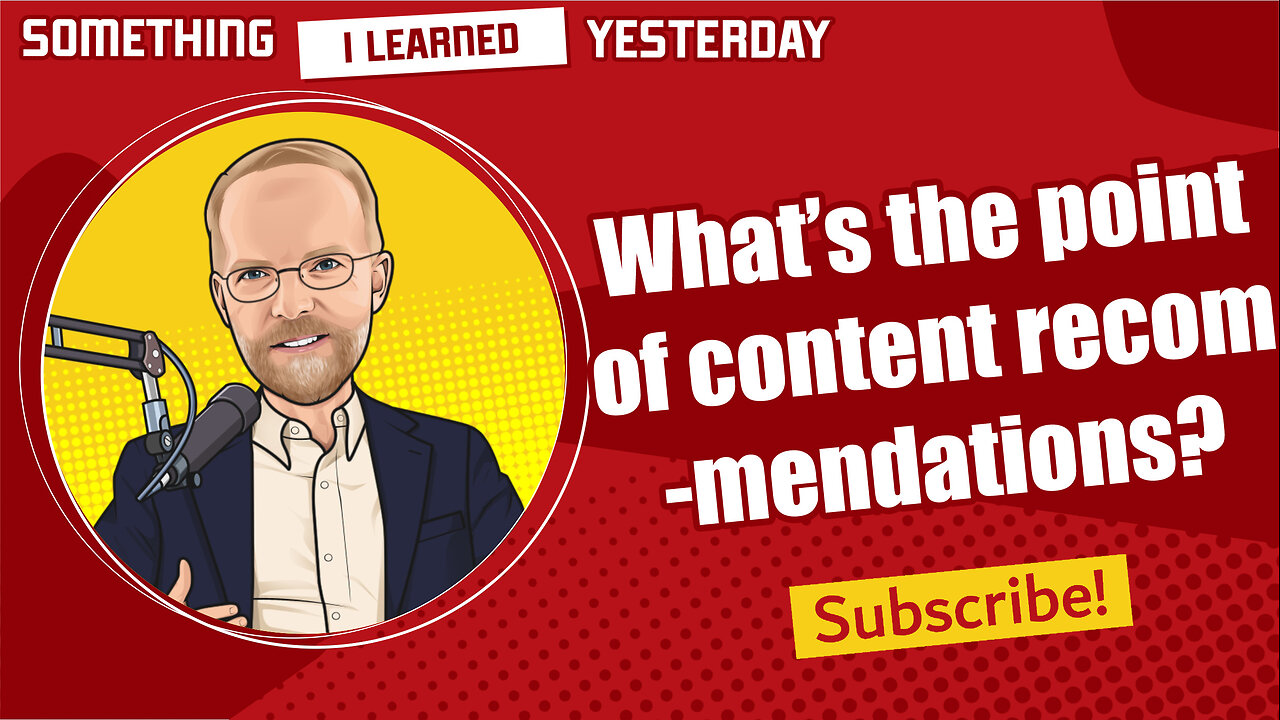Premium Only Content

206: What's the best content recommendation strategy?
“Recommended for you” is a successful strategy for engagement and for sales. Amazon recommends products I might want. Spotify recommends music I might like. They both do a pretty good job. They find people who have similar buying or listening habits to me, and see what’s popular with that group.
Content websites do the same. I believe it started with “related articles.” You’d read an article and there would be a link at the bottom to similar articles. In some cases I saw that became a battle between editorial and technological curation. From one perspective, the “read more” links are part of the message of the page.
What does “related articles” mean? It could mean
* on the same topic
* by the same author
* about the same length
* at the same level of depth of specificity
“Similar” can mean a lot of things.
Is the point to allow the reader to dig in more deeply, or to browse? If I just read a basic article about infantry in the Civil War, do I want to go more deeply into infantry, or do I want a basic article about cavalry? Is the website designed to educate on a topic, or just to get more clicks?
Let’s say your business has extensive data on your customers and your CDP knows that this particular reader likes to read superficial, slightly humorous stuff on Monday mornings. But somehow he ends up on an article about infantry in the Civil War. Are you going to recommend something related to that article, or something related to the behavior you’ve observed? In that case, the “more for you” section could have nothing to do with warfare at all.
There’s almost no end to the way you can parse content recommendations.
* Popular articles on the site right now
* Popular articles in a specific category that the user has expressed interest in
* Popular articles by an author that the user has frequently read
* Articles read by visitors who read the current article
* Articles that visitors with similar browsing history have read
* Popular articles for people with a specific job title
* Articles read by people who are like the reader
* Articles read by people in a specific geographic area
It’ll make your head spin. So let me try to make it simpler.
Are you trying to serve the reader or are you after advertising revenue? In each case, how would you measure success?
I’ll start with ad revenue, because I think that’s what most people are trying to do.
In that case, your metrics are simple. You want more views of high-value pages. That might just mean more total page views, but not always. If you’re running a sponsorship on the section of your website that talks about annuities, you don’t really care that the reader is more interested in the Civil War. You want to push him to a page about annuities. And you don’t even care if he reads the article. You want him to see and/or click on the ads.
If, on the other hand, you’re trying to serve the reader’s interests, that gets more complicated because you need a way to measure satisfaction. You could ask your readers what they want, but you can also look at statistics like …
* Bounce rate
* Pages per session
* Time on the page
* Scroll depth
* Heatmaps
You might also want to give the reader some options. As I discussed above, “similar” is a squishy word. You could let the reader choose his own path – maybe “go deeper,” “more from this author,” or “popular articles on this topic.” Don’t actually say “this topic.” Name the topic so they know what they’re getting.
All these things are testable but only if you have the technology to do them. Sometimes content recommendation engines are very limited. You want to think about the ways you might want to recommend content and make sure your technology is able to help you with the approaches you want to test.
-
 LIVE
LIVE
The Dan Bongino Show
1 hour agoDemocrat Donor Admits The Scary Truth (Ep. 2393) - 12/23/2024
98,905 watching -
 LIVE
LIVE
Matt Kohrs
12 hours agoRumble CEO Chris Pavlovski Talks $775M Tether Partnership || The MK Show
2,582 watching -
 28:23
28:23
Dave Portnoy
12 hours agoDavey Day Trader Presented by Kraken - December 23, 2024
55.3K24 -
 59:29
59:29
BonginoReport
3 hours agoTrump, Murder Plots, and the Christmas Miracle: Evita + Jack Posobiec (Ep.110) - 12/23/2024
51.8K53 -
 LIVE
LIVE
Wendy Bell Radio
6 hours agoNothing To See Here
10,919 watching -
 2:12:18
2:12:18
TheDozenPodcast
22 hours agoIslam vs Christianity: Bob of Speakers' Corner
55.7K15 -
 14:36
14:36
The StoneZONE with Roger Stone
1 day agoRoger Stone Delivers Riveting Speech at Turning Point’s AMFEST 2024 | FULL SPEECH
72.4K23 -
 18:59
18:59
Fit'n Fire
12 hours ago $5.13 earnedZenith ZF5 The Best MP5 Clone available
35.5K1 -
 58:34
58:34
Rethinking the Dollar
21 hours agoTrump Faces 'Big Mess' Ahead | RTD News Update
31.2K5 -
 5:35
5:35
Dermatologist Dr. Dustin Portela
21 hours ago $1.63 earnedUnboxing Neutrogena PR Box: Skincare Products and Surprises!
24.5K4